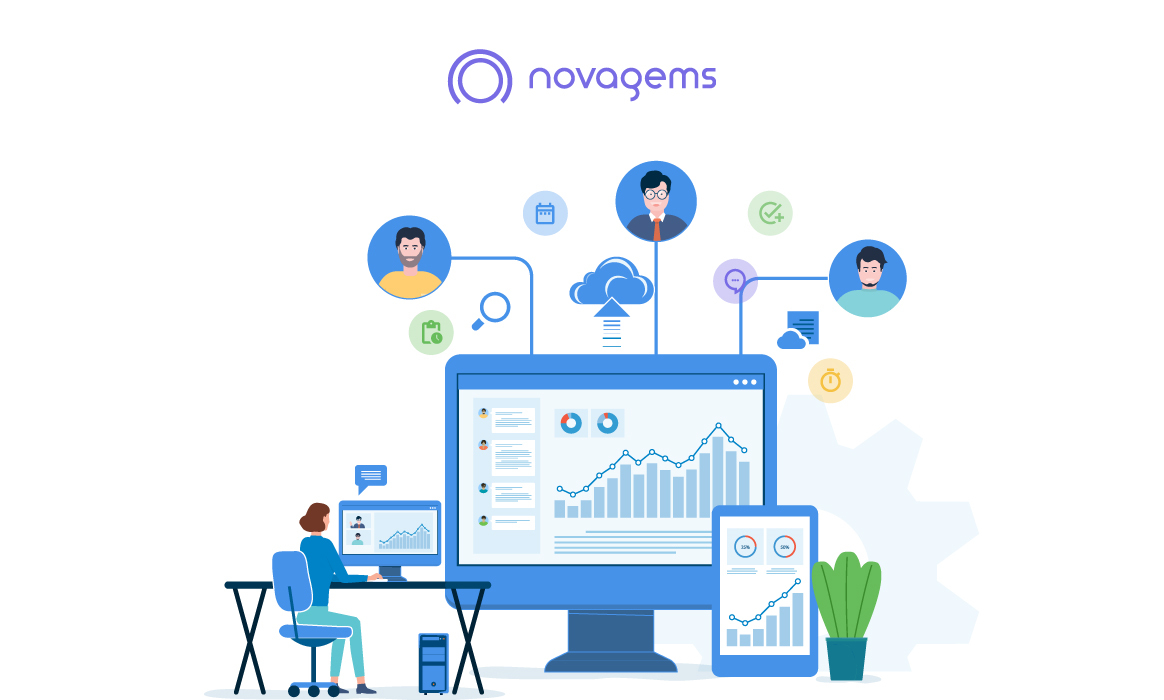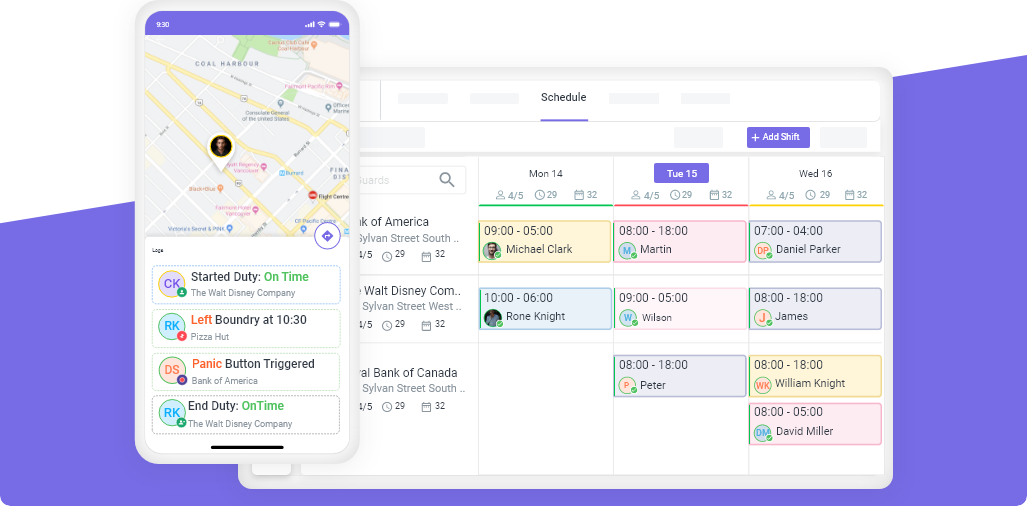How You Can Uplift Your Small Business With Workforce Management Software
Tue, Jun 20, 2023
Read in 12 minutes
Being a small business in the big world can be scary. With the help of good workforce management software compete with the industry giants and make a name for yourself. Give your workforce the right tools to uplift themselves.

There was a time when working meant having to do a 9-5 job and the last half an hour usually consisted of sorting through loads and loads of paperwork. But times have changed drastically and now the work has been made easier with workforce management software.
Running a small business requires balancing many responsibilities, from managing employees to ensuring smooth operations. As businesses grow, the challenge of keeping everything organized increases. Starting a new company can be scary in itself.
You need to make a plan for your business, engage the employees, and increase productivity. Sometimes it can be very hectic to manage all of this. This is where workforce management (WFM) software can play a crucial role. It helps you streamline operations, manage employees effectively, and stay ahead of emerging trends.
Whenever we think of workforce management software, we imagine a huge workplace with different departments and hundreds of employees behind their computer screen. But that is not the case. Workforce management has bought a huge uplift in small businesses as well. It has helped them streamline their operations and increase efficiency. In today’s competitive business landscape, small enterprises must embrace technological solutions to enhance their operational efficiency. Workforce management software is a powerful tool that can uplift your small business by streamlining essential processes, improving productivity, and optimizing your workforce.
What is Workforce Management?
Workforce management (WFM) refers to a set of tools and processes designed to optimize the productivity and efficiency of your workforce. It helps small businesses manage tasks like employee scheduling, time tracking, payroll, and performance management. By centralizing these functions, WFM software allows business owners to have better control over their teams while improving overall efficiency.
Key benefits of WFM software include:
- Automated employee scheduling.
- Real-time tracking of employee work hours.
- Simplified payroll and attendance management.
- Data-driven insights for better decision-making.
With the right WFM software, small businesses can save time, reduce administrative errors, and focus on growing their operations.
Why Small Businesses Choose Advanced Workforce Management Solutions
Efficient management is essential for any business whether it is small or on a larger scale. It will not only boost productivity but will increase efficiency of the employees as well.
-
Improved Employee Engagement
Workforce management software often includes employee self-service portals where employees can access their schedules, request time off, view pay stubs, and update personal information. By providing employees with easy access to this information, you empower them and improve their engagement. Employees can manage their schedules, plan their time off, and access important HR-related information independently, reducing administrative burden and increasing overall satisfaction.
With limited resources the management has to look at resource allocation optimization in unique ways. Engaged employees means higher productive employees. Small business owners need to make sure that their employees are not burning out due to excessive workload as the price to retain them is far less than hiring a new person.
A small business’s efficiency can be easily determined from their happy employees. Create a framework that will work seamlessly with your business goals and employees and bridge the gap between.
-
Better Operational Efficiency
After everything went on a standstill after Covid, small businesses were the ones which were affected the most. They were used to operating in an office space and it was always easy to gauge the performance enhancement when the employees were working from the office.
But remote work is here to stay and small businesses need to adapt accordingly. In a way resource management software will guide the business owners in cutting the overhead costs and streamlining the processes. The management can easily keep a track of the working hours of the employees even if they are doing a non desk job.
-
The Growing Need for Flexibility
In today’s fast-paced business world, flexibility is more important than ever. Employees value flexible working hours, and businesses need to adapt to these changing needs. Workforce management software can help you create more flexible work arrangements without compromising productivity.
- Flexible Scheduling: WFM software allows for easy shift swapping, time-off requests, and real-time updates on schedules. This gives employees more control over their work-life balance.
- Remote Work Management: With the rise of remote work, small businesses can use WFM tools to track remote employees, manage their tasks, and ensure accountability.
- Scalable Solutions: As your business grows, WFM software can scale with you, ensuring that your operations remain efficient regardless of the size of your team.
Offering flexibility to your employees improves morale and productivity, which ultimately benefits your business.
-
Streamlined Communication
Effective communication is crucial for small businesses. Workforce management software offers tools for streamlined communication, including instant messaging, notifications, and task assignments. It enables quick and efficient communication between managers and employees, leading to better coordination, improved teamwork, and faster problem resolution.
Workforce scheduling optimization brings a seamless communication between the teams.
-
Employee Well-Being
Employee well-being has become a top priority for businesses, especially in the wake of the COVID-19 pandemic. A happy, healthy workforce is more productive and less likely to experience burnout. Workforce management software can help monitor and improve employee well-being.
- Tracking Work Hours: Ensuring that employees don’t work excessive overtime is essential for maintaining work-life balance. WFM software tracks employee hours, making it easier to manage workloads.
- Scheduling Breaks: The software helps schedule breaks and ensures that employees are taking time off when needed.
- Mental Health Support: Some workforce management platforms offer wellness features, such as surveys to gauge employee satisfaction and tools for mental health support.
By focusing on employee well-being, you can create a healthier and more motivated workforce, which leads to better business outcomes.
Workforce management software enables you to create accurate and optimized work schedules based on factors such as employee availability, skills, and business demand. It helps you avoid overstaffing or understaffing, leading to better resource utilization and improved customer service.
Small business operations enhancement can be easily achieved with efficient scheduling. As small businesses already have limited resources there is a greater chance of employees feeling overwhelmed with work when there is not efficient workforce planning.
-
Get to Know Gen Z
As Gen Z enters the workforce, small businesses need to understand how to engage and manage this new generation of workers. Gen Z employees value technology, flexibility, and work-life balance, and workforce management software can help you meet these expectations.
- Tech-Savvy Tools: Gen Z is comfortable with technology, so using WFM software that offers a user-friendly interface and mobile accessibility will appeal to them.
- Transparency and Communication: This generation values open communication and feedback. WFM tools can provide real-time updates and allow for clear communication between managers and employees.
- Development and Growth: Gen Z workers are keen on career development. Workforce management software can track employee performance, set growth goals, and provide training opportunities.
Understanding and meeting the needs of Gen Z employees will help you attract and retain young talent.
-
Time and Attendance Tracking
The software can automate time and attendance tracking, eliminating manual processes such as paper timesheets. This reduces errors, ensures accurate record-keeping, and simplifies payroll processing. It also enables you to monitor employee attendance, track breaks, and manage overtime more effectively.
Digital timesheets are easy to maintain and the management can easily track the progress of the employees. This automatically increases the productivity of the employees.
The debate of work life balance has been gaining momentum for the past few years now. Employees are being encouraged by the companies to take proper rest as this will decrease the burnout of the employees. But as the employees are taking leaves, the management needs to take care that the burden is not falling on the rest of the team. The management needs to have an optimized way in which they can keep track of the leave requests too.
-
Embrace AI and Automation
AI and automation are transforming workforce management. For small businesses, leveraging these technologies can lead to increased productivity, cost savings, and better decision-making.
- Automating Repetitive Tasks: WFM software can automate tasks such as scheduling, payroll, and time tracking, reducing the need for manual work and minimizing errors.
- Predictive Analytics: AI can analyze past trends to predict future staffing needs, helping businesses optimize their workforce and avoid overstaffing or understaffing.
- Chatbots and Virtual Assistants: Some WFM platforms use AI-powered chatbots to answer employee questions, schedule shifts, and handle administrative tasks automatically.
Embracing AI and automation allows small businesses to operate more efficiently, saving time and resources.
-
Greater Return On Investment
Once the business has got a better idea of how to minimize the overhead costs then they can start expecting more return on their investments. With operational efficiency workforce productivity improvement can be expected for the better future of the company. The ROI achieved from workforce management software is greater than the manual processes being followed.
Emerging Trends in Workforce Management
Workforce management is evolving, and several trends are shaping how small businesses handle their operations. Keeping an eye on these trends can give you an advantage.
- Cloud-Based Solutions: Cloud-based WFM tools allow small businesses to manage their teams remotely, providing flexibility and real-time updates on workforce activities.
- Mobile Accessibility: Employees and managers can access WFM platforms from their smartphones, ensuring smooth operations even when they are on the go.
- Data-Driven Decisions: Workforce management tools are incorporating analytics to help businesses make informed decisions. You can monitor employee performance, track labor costs, and optimize schedules based on data.
By adopting these trends, small businesses can stay competitive and meet the growing demands of modern workforce management.
Challenges Small Businesses Face
Small businesses often face unique challenges when it comes to managing their workforce. They can uplift resources management with the proper wfm for the small business. These challenges can include:
1. Limited Resources: Small businesses often operate on tight budgets, making it challenging to hire additional staff for workforce management. Workforce productivity optimization is essential even if the employees working in the company are less.
2. Time Constraints: Small business owners wear multiple hats, leaving them with limited time to focus on workforce-related tasks.
3. Compliance Issues: Staying compliant with labor laws and regulations can be overwhelming without dedicated HR personnel. If you have just started in the industry and are just building in the team then having a workforce management for small businesses is crucial from an earlier stage only.
4. Manual Processes: Many small businesses rely on manual methods for scheduling, time tracking, and payroll, leading to errors and inefficiencies.
Best Practices for Small Business Workforce Management
To get the most out of your workforce management software, follow these best practices:
- Regularly Update Software: Ensure your WFM software is up-to-date to take advantage of new features and improvements.
- Train Employees: Make sure both managers and employees understand how to use the software effectively.
- Set Clear Policies: Use the software to establish clear policies on time tracking, scheduling, and employee performance.
Implementing these best practices will help streamline your business operations and ensure your workforce management efforts are effective.
Recognize and Reward Hard Work
Finally, it’s essential to recognize and reward hard work. When employees feel appreciated, they are more likely to stay with your company and perform at a high level.
- Track Employee Achievements: WFM software can track employee performance and achievements, making it easier to recognize top performers.
- Offer Incentives: Use data from your WFM platform to create incentive programs based on productivity, attendance, or customer feedback.
- Public Recognition: Celebrate employee successes through company-wide announcements or reward programs to boost morale.
By recognizing and rewarding hard work, you build a positive company culture and increase employee retention.
The Role of Workforce Management Software
This is where workforce management software for small business comes to the rescue. It’s designed to streamline and automate these essential workforce processes, making them more efficient and accurate. With workforce management software, you can:
- Create and manage employee schedules easily.
- Accurately track employee time and attendance.
- Assign tasks and monitor their progress.
- Evaluate employee performance with data-driven insights.
- Streamline payroll and compensation processes.
Choosing The Right Software
Selecting the right workforce management software for your small business is crucial. It not only brings an uplift in productivity overall in the company but will optimize workforce productivity as well. Consider factors such as:
- Your budget
- Scalability
- Integration capabilities with existing systems
- User-friendliness for you and your team
Evaluate different workforce management software for small business options and choose one that aligns with your business’s unique needs and goals.
Implementation and Integration
Once you’ve chosen the software, it’s essential to plan and execute its implementation carefully. Ensure that it seamlessly integrates with your existing systems and processes to maximize its benefits. You can dream of achieving workforce productivity optimization if you have the best wfm software in the market, but if it does not align with your current processes, then you will not achieve any desired results.
Overcoming Resistance and Training
Introducing new technology into your business can sometimes be met with resistance from employees. To overcome this, provide comprehensive training and communicate the benefits of the software. When your team understands how it will make their jobs easier, they are more likely to embrace it. If your employees understand that workforce management for small businesses is beneficial for them in the long run, they will be less resistant to learning it.
Conclusion
Workforce management software can be a game-changer for small businesses, empowering them to optimize their workforce operations and achieve new heights of success. By efficiently scheduling employees, tracking time and attendance, and implementing employee self-service options, businesses can enhance productivity, reduce costs, and improve customer service. Additionally, the performance management features, analytics capabilities offered by workforce management software further contribute to business growth and operational excellence.
Integrating this software with other systems enables seamless data exchange and streamlined processes across various departments. By embracing the power of workforce management software, small businesses can uplift their operations, drive efficiency, and pave the way for sustained success in today’s competitive landscape. Achieve an uplift in productivity with the ideal wfm for small business.
Workforce management software is a game-changer for small businesses. By automating tasks, improving employee well-being, and embracing flexibility, you can uplift your business and ensure long-term growth. Implementing these strategies will help you stay competitive in a fast-evolving market and create a more efficient, motivated workforce.
Get a Free Trial
Sign up For Newsletter
Latest Blog Posts
Get Started
Start being productive & grow your business
with Novagems




